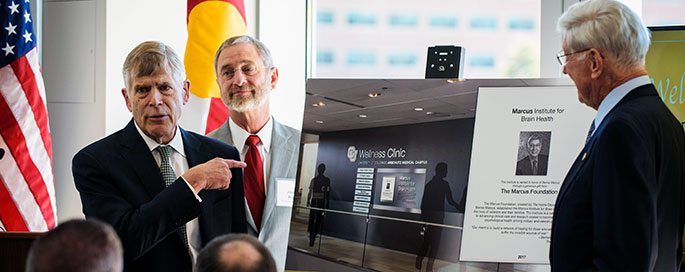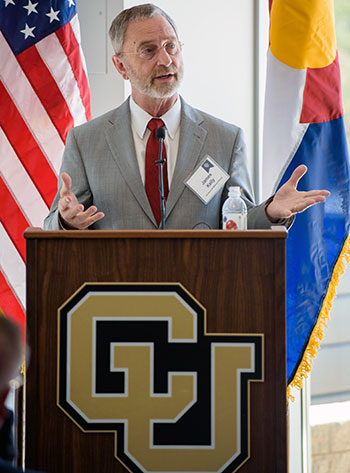Neurologist Returns to CU to Lead Program for Veterans
Marcus Institute for Brain Health

By Mark Couch
(December 2017) In spring 2017, the University of Colorado Anschutz Medical Campus a $38 million gift from the Marcus Foundation to establish the Marcus Institute for Brain Health (MIBH).
The institute, which will serve military veterans with traumatic brain injury and related psychological health issues, will be based on the Anschutz Medical Campus and will be the hub of a network of medical centers under development across the country.
At the announcement of the gift, Bernard Marcus, the retired co-founder of The Home Depot and founder of the Atlanta-based Marcus Foundation, said, “Our intent is to build a network of healing for those who served our country and suffer the invisible wounds of war.”
James P. Kelly, MD, professor of neurology, has been named
Kelly led the National Intrepid Center of Excellence (NICoE) at the Walter Reed National Military Medical Center for seven years. NICoE successfully treated more than 1,300 servicemen and women suffering from traumatic brain injury (TBI) and psychological health conditions using a patient-centered model that Kelly brings with him to the MIBH.
You are not new to the CU faculty.
This is my third tour of duty. I did my residency in neurology here in the 80s and then stayed for a year of what’s known as behavioral neurology, which is pretty well-established here. I was the first fellow here with Dr. Chris Filley, professor of neurology. I joined the faculty for four years and was here as an assistant dean of graduate medical education and a junior neurology faculty member.
Is that when you began studying traumatic brain injury?
My interest in TBI started during my fellowship when a young athlete was brought here basically brain dead after concussions two weeks apart and then having brain swelling – that’s called second-impact syndrome – and then dying from that.
I
I left in 1993 to become the director of the brain injury program at the Rehabilitation Institute of Chicago. I was there and on Northwestern’s faculty for 10 years, from ’93 until 2003 and served also as residency director of neurology.
Why did you return to Colorado in 2003?
My wife’s a Denver native, so we’d always planned on coming back. We didn’t figure we’d be in Chicago as long as we were. I reinserted into the University, but through neurosurgery as opposed to neurology because they were much more interested in trauma.
 How did you get involved in providing care to members of the military?
How did you get involved in providing care to members of the military?
The Defense Department recognized in about ’05 that they had a problem with guys coming back from Iraq and Afghanistan. Some of us with sports concussion backgrounds were asked to advise them. I was invited to a new committee as the national subject matter expert. They set up a TBI subcommittee and I chaired it. The general who was tasked with addressing TBI, PTSD, and psychiatric health problems called me into her
This was in April ’08 and the plan at that point was to have a center of excellence for the most complex and comorbid neuropsychiatric cases coming back from the war zones, taking care of them and disseminating lessons learned in real time so that others could benefit from that care as well.
This center was intended to take care of the warriors coming back from the battle zones. The referrals came from big military centers like Fort Bragg and Camp Lejeune. We received most of our patients from those locations initially. Then the special operations community, the Navy SEALs, the Delta Force
How did you meet the Marcus Foundation?
The model was well known to the people at the Marcus Foundation in Atlanta. Marcus Ruzek, representing the Foundation, visited the center while I was
The center had opened in 2010. The generals and admirals in my reporting chain had asked me to stay after my initial two-year commitment. And I did it for five more years. At that point, things are up and running, so I moved back to Colorado. I had figured I was going to work at the center for two years, maybe four. Then it ended up being seven years because it was magnificent. I was getting to do stuff that was just unbelievable. The whole mission was like nothing else.
In any case, Marcus Ruzek contacted me and I was being recruited to Emory University at the time and so I said, ‘Listen, I’m coming down there for a recruitment visit. Let’s talk because that’s where the Foundation is based. I thought they wanted something on the East Coast. Or maybe in their home town. And the answer was, no. They said, ‘Where do you want it?’ And I said, ‘Really?’ I live in Colorado, it’s a magnificent place. I know a lot about it. It’s a healing environment. One thing led to another with discussions over the next almost two years. I left the center in August 2015. It was May this year when we made the announcement of the Marcus Institute for Brain Health. It was about a year and a half of ongoing discussions, planning and working with the leadership in the Chancellor’s office and the Dean’s office.
What advantages are there being here rather than elsewhere?
Colorado as a state is among the leaders in the newly retired or veteran population
And the leadership at this particular campus is
You’ve got a former military medical center for the army, where President Eisenhower once received his care. We have
What are
It’s hiring right now. Making sure we hire the right people in
And we have this building (the Anschutz Health and Wellness Center), which was built while I was gone. I knew it was being built, but I didn’t know anything about this place. We come back to a place that has
My philosophy is that what we need to do is to help these veterans reincorporate and make the transition to civilian life, not create yet one more veterans-only system, but incorporate their health care into a civilian health care system.